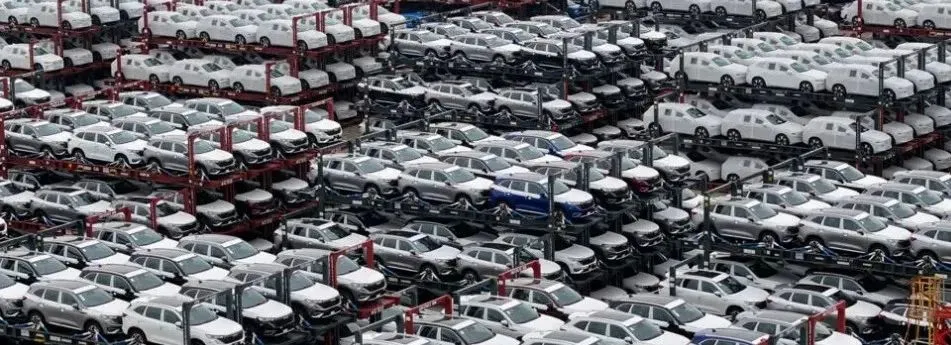Abstract
Recently, the European Union officially announced that it will impose a five-year anti-subsidy tariff on electric vehicles imported from China. Specifically, SAIC Group’s products will be subject to a tariff of 35.3%, while Geely Automobile and BYD will face tariffs of 18.8% and 17%, respectively. For companies that were not sampled but cooperated with the investigation, the EU will uniformly impose a tariff of 20.7%; those that did not cooperate with the investigation face a maximum tariff of 35.3%.

According to the latest data, in the first three quarters of 2024, the total export value of electric vehicles, lithium batteries, and photovoltaic products from our country reached 757.83 billion yuan, accounting for 4.1% of the total national export value. These three categories of green and low-carbon products are widely welcomed in the global market and have secured a certain market share in more than 200 countries and regions. Currently, the global new energy industry is developing rapidly, and China’s exports provide a rich supply to the international market, helping to alleviate inflationary pressures. At the same time, these green and low-carbon products have also played a significant role in addressing climate change and promoting sustainable development. Despite this, China and the EU are still negotiating a price commitment agreement, planning to avoid tariff increases by raising the selling price of electric vehicles and limiting export quantities. However, there are still disagreements between the two sides on core issues such as determining the minimum price and whether to allow companies to reach price agreements separately. In addition, tariff policies from the United States and the European Union have already had a real impact on the data performance of the electric vehicle and its upstream lithium battery industry chain.
In the first three quarters of 2024, China’s exports of electric vehicles to EU countries significantly slowed down, with exports of pure electric vehicles and plug-in hybrid vehicles declining by 7% and 3% year-on-year, respectively.
At the same time, exports of pure electric vehicles to the Oceania and US-Canada markets also saw a decrease of 35% and 22%, while exports of plug-in hybrid vehicles to the Japanese and South Korean markets dropped by 57%.
Structurally, the export decline of new energy buses and special-purpose vehicles is significant, with the export increase of new energy buses from January to September being only 0.7 ten thousand units, remaining flat year-on-year.
The export proportion of power batteries continues to decline, with the export volume of power batteries in September accounting for less than 20% of the sales volume for that month, a drop of more than 8 percentage points from the previous month.
Data from January to September indicates that the cumulative export volume of power batteries accounts for less than 19% of the sales volume for the first nine months. In terms of scale, the export volume of power batteries in September decreased by 5% year-on-year, with the decline in iron-lithium batteries reaching about 13%; while the cumulative year-on-year decline in ternary power batteries exceeded 6%.
Domestic battery companies have seen a divergence in the growth rate of power battery exports, with some leading companies experiencing negative growth of over 30% and 20% in September and the first three quarters, mainly due to adjustments by major overseas automakers in the supply structure of power batteries for North America.
In September, China’s exports of lithium iron phosphate exceeded 538 tons for the first time since 2017, with a month-on-month increase of 105% and a year-on-year increase of 1212%, mainly due to overseas electric vehicle and battery manufacturers shifting to lithium iron phosphate technology. However, the average export price fell by nearly 70% year-on-year. During the same period, the export volume of ternary materials exceeded 4,000 tons, but due to reduced demand, both month-on-month and year-on-year figures showed a decline.
The export volume in September exceeded 47,000 tons, but the growth rate was only in the single digits, while the average export price decreased by 12% month-on-month and 42% year-on-year. In natural graphite, the exports of flake graphite and spherical graphite also declined, partly due to overseas customers stocking up in advance to prepare for the election.
The export of lithium salt lithium hexafluorophosphate has declined by more than 35% month-on-month and by more than 50% year-on-year, reflecting a weakening demand for lithium battery products overseas. In the complex market situation, lithium battery companies are adjusting their strategies in real-time, cautiously and resolutely pushing forward with the layout of overseas production capacity to seize opportunities in the global new energy market.
Enjie Shares, Concord and Shante Technology also plan to build production capacity for separators, structural parts, and anode materials in Malaysia. The investment scale of multiple projects reaches the level of 1 billion yuan, showing the determination of lithium battery companies to increase their production capacity layout in Southeast Asia.
At the same time, lithium battery companies are also accelerating the pace of enhancing the localization of battery supply capacity in Europe. CATL states that its German factory is expected to achieve break-even within the year, while the factory in Hungary is advancing equipment installation and is expected to start production in 2025.
In September of this year, the company’s second European factory in Hungary was also officially launched, which is expected to add 100GWh of production capacity. Companies such as Eve Energy, Envision Power, CALB, and Sunwoda have also made new progress in the layout of battery production capacity in Europe, including Turkey, Spain, Portugal, and Hungary.
Eve Energy also mentioned that its global supply chain system is accelerating globalization with the layout of battery production capacity. The company’s investment in a laterite nickel ore hydrometallurgical project in Indonesia has been successfully put into production, with an annual output of about 120,000 tons of nickel metal and 15,000 tons of cobalt metal, continuously improving the cost-effectiveness of its global production capacity.
*From the public account EastChem MicroView